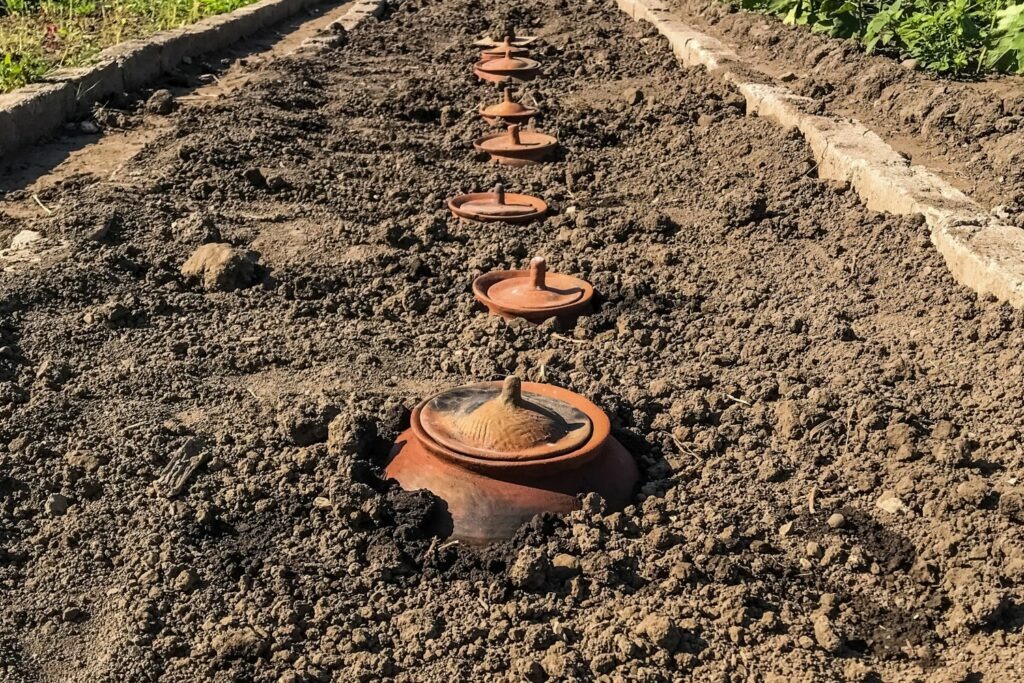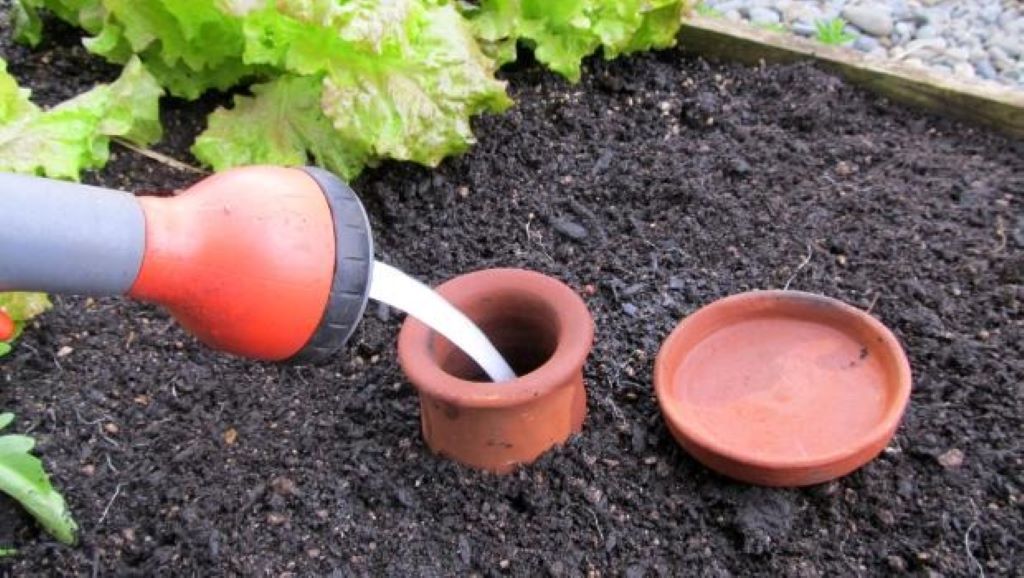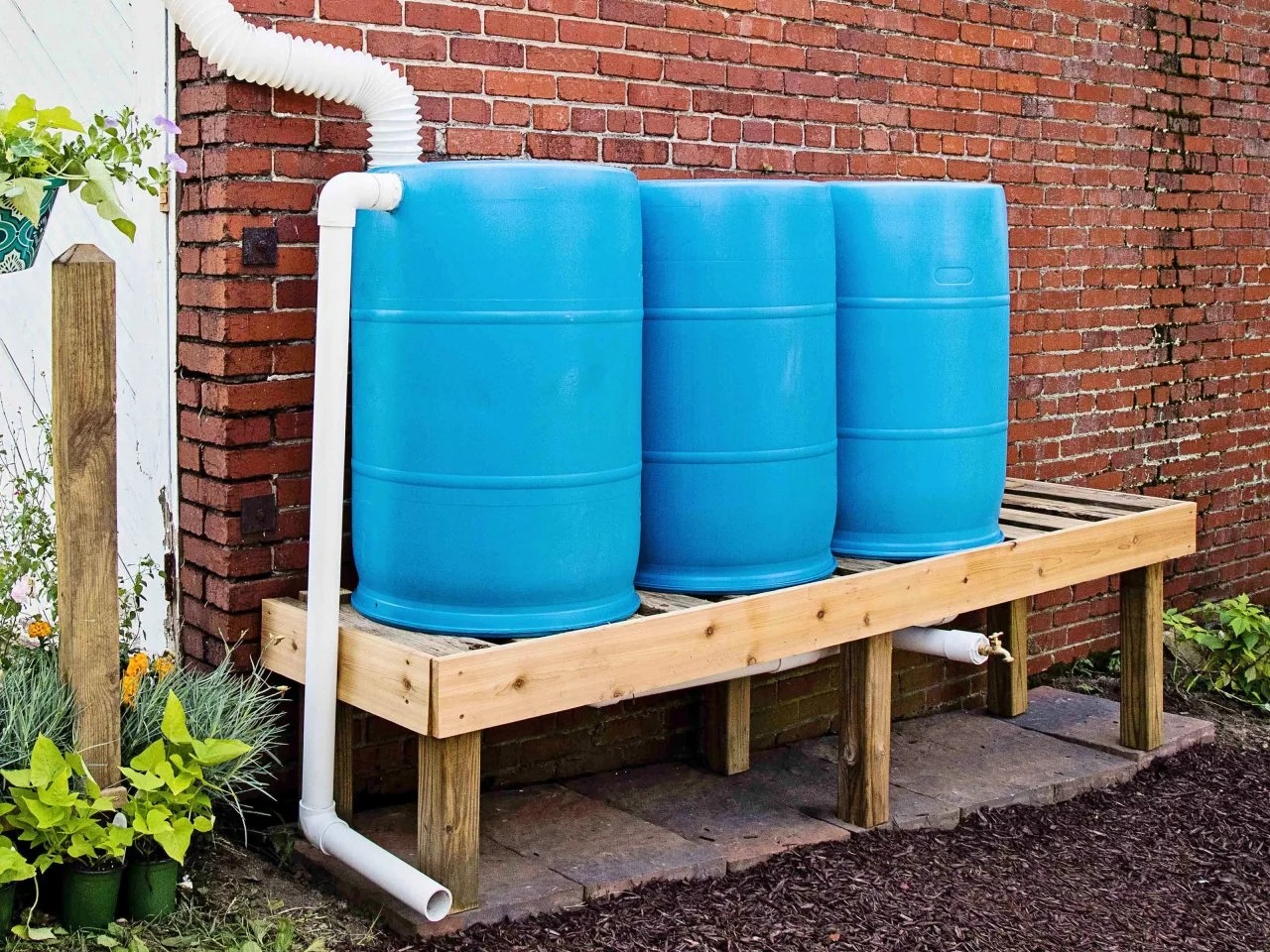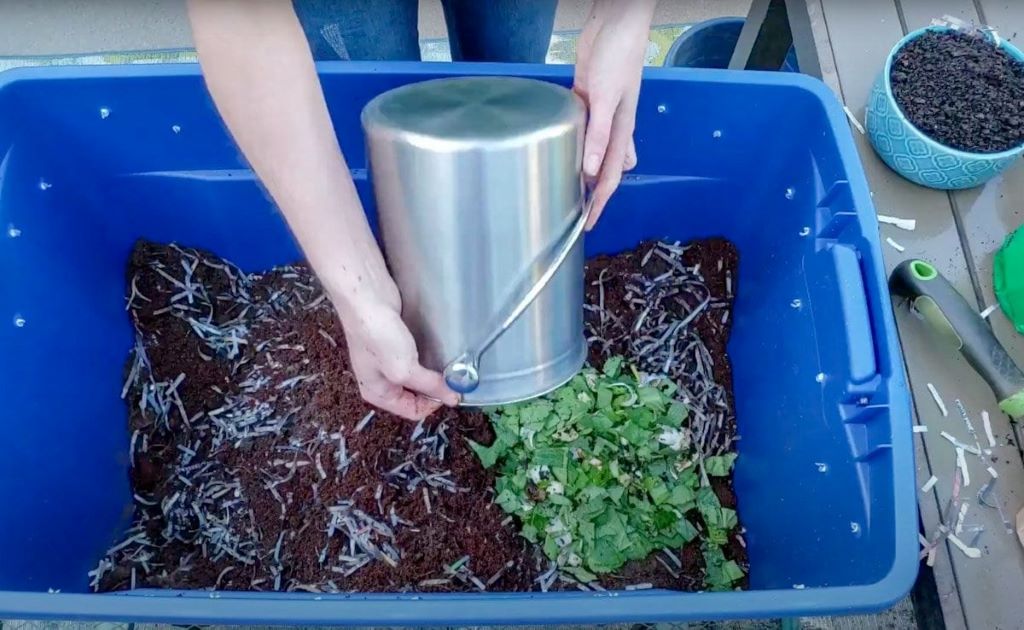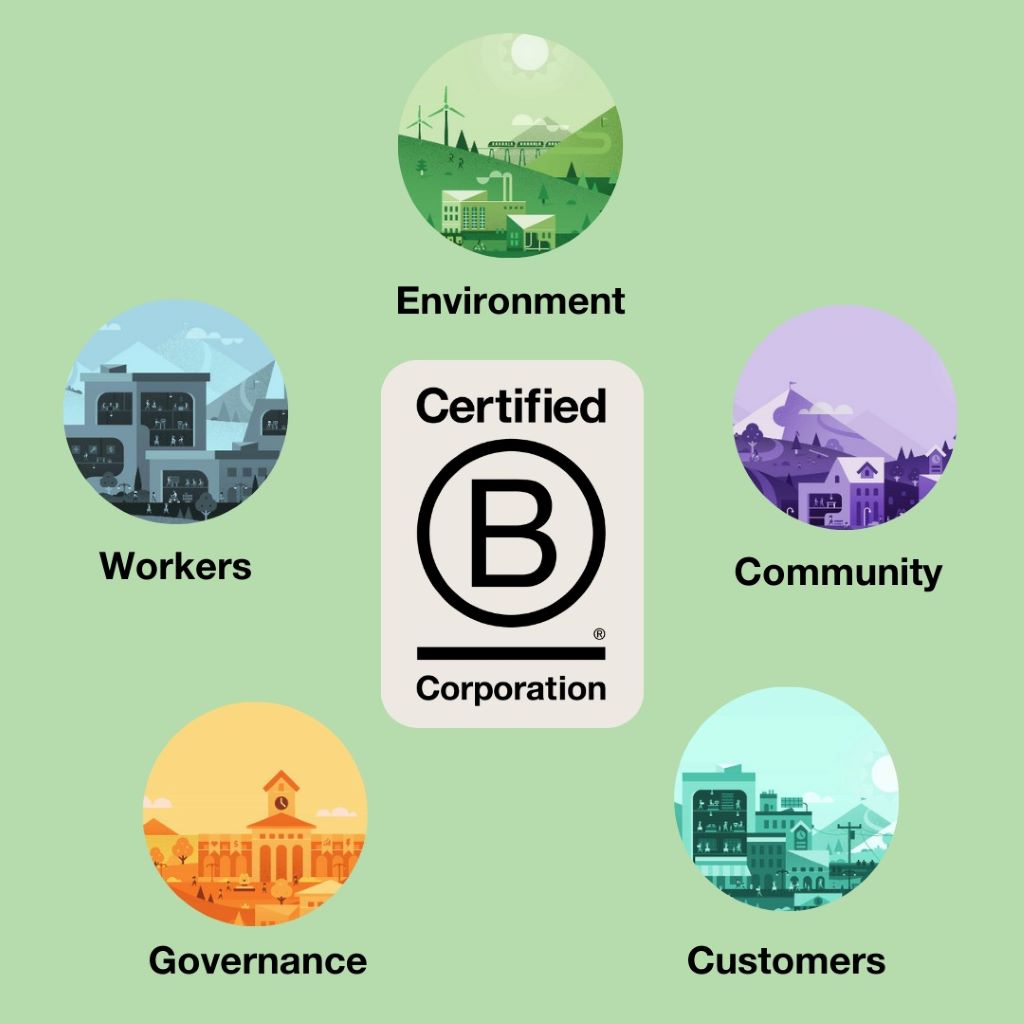Imagine watering your garden with less effort and better results. Olla irrigation pots make that possible. These ancient clay vessels deliver water directly to plant roots. They save time, reduce water waste, and promote healthier plants. Gardeners worldwide are rediscovering this sustainable method. Curious about how olla pots work? This guide explores their benefits, history, and practical use. You’ll learn everything to transform your garden with olla irrigation.
What Are Olla Irrigation Pots?
Olla irrigation pots are unglazed clay pots buried in soil. They slowly release water through porous walls. Plants draw water as needed, ensuring deep watering. This method mimics natural hydration for plant roots. Unlike drip irrigation or watering cans, ollas prevent overwatering. They work well in raised beds, container gardens, and grow bags.
How Olla Pots Work
Olla pots rely on soil moisture tension. The clay’s porous walls allow water to seep out slowly. Plant roots absorb this water based on their needs. The process reduces water stress and promotes bigger harvests. You fill the pots periodically, depending on water capacity and soil type. This self-watering system saves time and resources.
The History of Olla Irrigation: A Timeless Technique
Olla irrigation dates back thousands of years. Native American tribes in the American Southwest used clay vessels for watering crops. Spanish settlers later adopted the technique. In Mexico, Mata Ortiz pottery by Juan Quezada revived traditional clay formulas. These cultures valued ollas for their watering efficiency. Today, modern gardeners use ollas to grow sustainable gardens.
Cultural Significance of Ollas
Ollas reflect ingenuity across cultures. The Catawba potter communities crafted durable clay pots. Spanish settlers integrated ollas into their farming practices. These traditions inspire today’s Thirsty Earth Olla Watering System and The Olla Company. Ollas blend history with modern irrigation technology.
Benefits of Using Olla Irrigation Pots
Olla pots offer many advantages for gardeners. They save water, time, and effort. Here are the key benefits:
1. Water Efficiency
Olla pots reduce water use by up to 70%. They deliver water directly to roots. This minimizes evaporation and water waste. Unlike soaker hoses or drip line irrigation, ollas prevent surface water runoff.
2. Healthier Plants
Plants get consistent moisture without overwatering. This promotes fibrous root systems and better nutrient uptake. Bell peppers, tomatoes, and other garden plants thrive with ollas. They also reduce weed control issues by limiting surface water.
3. Low Maintenance
Once buried, olla pots need refilling every few days. This depends on water level, soil type, and climate. Gardeners spend less time watering entire garden beds. It’s ideal for busy schedules or water restrictions.
4. Eco-Friendly Solution
Ollas support sustainable gardening. They work with rainwater harvesting systems or upcycled water. Unglazed pottery is natural and biodegradable. Using ollas aligns with eco-conscious practices like those from The Cottage Peach.
5. Frost Protection
Buried ollas insulate roots from frost temperatures. They reduce frost risk in colder climates. This makes them suitable for year-round gardening in various regions.
How to Choose the Right Olla Pot
Choosing the right olla pot depends on your garden’s needs. Consider these factors:
1. Size and Compatibility
Olla pots come in various sizes. Small pots suit container gardens or grow bags. Larger pots work for raised beds or large-scale gardens. Check water capacity to match your plants’ needs.
2. Material Quality
Look for premium clay or natural clay pots. Unglazed terra cotta ensures proper water seepage. Avoid glazed pots, as they block water flow. Brands like Thirsty Earth and The Olla Company offer reliable options.
3. Soil Type
Sandy soils need frequent refilling due to fast drainage. Clay-heavy soils retain moisture longer. Test soil moisture to choose the right pot size. This ensures optimal watering efficiency.
4. Budget and Availability
DIY olla pots are budget-friendly. You can make them from terracotta plant pots. Ready-made options are available with free USA shipping from brands like Shop Spikes or Global Buckets.
How to Use Olla Irrigation Pots in Your Garden
Setting up olla pots is simple. Follow these steps for success:
Step 1: Choose Your Location
Place ollas in raised beds, garden beds, or near plant roots. Ensure the pot’s rim stays above soil for refilling. Space pots 2–3 feet apart for even watering.
Step 2: Bury the Pot
Dig a hole deep enough to bury the pot, leaving 2 inches above soil. Pack soil around the pot tightly. This prevents air gaps and ensures proper water flow.
Step 3: Fill with Water
Fill the pot with water and cover it with a lid or stone. This prevents debris and evaporation. Check the water level every 2–4 days, depending on climate.
Step 4: Monitor and Refill
Use a watering schedule based on your plants’ needs. Refill pots when water levels drop low. Combine with a rain barrel for sustainable water use.
Step 5: Maintain Your Ollas
Clean pots annually to remove soil buildup. Store them indoors during frost to prevent cracking. This extends their lifespan for years of use.
DIY Olla Pots: A Budget-Friendly Option
Want to save money? Make your own olla pots. Here’s how:
Materials Needed
- Two terracotta plant pots
- Waterproof sealant
- A small cork or clay lid
- Sandpaper
Steps to Create a DIY Olla
- Seal the drainage hole of one pot with sealant.
- Glue the rims of two pots together to form a closed vessel.
- Sand the sealed area for a tight fit.
- Bury the DIY olla in your garden bed.
- Fill with water and cover with a cork or lid.
DIY ollas work as well as store-bought ones. They’re perfect for small gardens or testing the system.
Olla Pots vs. Other Irrigation Methods
How do ollas compare to drip irrigation, soaker hoses, or watering cans? Here’s a breakdown:
Olla Pots
- Pros: Saves water, low maintenance, eco-friendly, promotes deep watering.
- Cons: Initial setup cost, not ideal for large-scale farms.
Drip Irrigation
- Pros: Precise watering, good for large gardens.
- Cons: Requires setup, maintenance, and electricity for pumps.
Soaker Hoses
- Pros: Affordable, easy to install.
- Cons: Wastes water, less precise, prone to clogging.
Watering Cans
- Pros: Simple, no setup needed.
- Cons: Time-consuming, inconsistent watering, high water waste.
Ollas shine for small to medium gardens. They blend tradition with modern efficiency.
Best Plants for Olla Irrigation
Olla pots work well for many plants. Here are top choices:
- Bell Peppers: Thrive with consistent moisture.
- Tomatoes: Benefit from deep root watering.
- Herbs: Basil and rosemary love steady hydration.
- Root Vegetables: Carrots and beets grow stronger roots.
Avoid using ollas for plants needing dry soil, like succulents. Match your plants to the system for best results.
Tips for Maximizing Olla Irrigation Efficiency
Want bigger harvests? Try these tips:
- Use a drainage tray to catch excess water.
- Combine with plant feed for better nutrient uptake.
- Test soil moisture regularly to adjust refilling.
- Pair with grow bags for portable gardens.
- Use watering spikes for small pots or containers.
These practices enhance your garden’s health and productivity.
Environmental Impact of Olla Irrigation
Olla pots promote sustainable gardening. They reduce water waste and support eco-friendly practices. Using rainwater harvesting systems cuts reliance on mains water reservoirs. Unglazed clay pots are biodegradable and safe for the environment. They align with global efforts to combat water stress.
Where to Buy Olla Irrigation Pots
Ready to try ollas? Here are trusted sources:
- The Olla Company: Offers premium clay pots with free shipping.
- Thirsty Earth: Specializes in self-watering clay olla pots.
- Shop Spikes: Provides watering cones and ollas for small gardens.
- Global Buckets: Focuses on sustainable irrigation solutions.
Check size and compatibility before purchasing. Many offer free USA shipping for convenience.
FAQs
What Are Olla Irrigation Pots Made Of?
Olla pots are made of unglazed terracotta or natural clay. Their porous walls allow slow water release. This ensures efficient irrigation for plant roots.
How Often Should I Refill Olla Pots?
Refill every 2–4 days, depending on soil type and climate. Sandy soils need more frequent refills. Check water levels regularly for best results.
Can I Use Olla Pots in Containers?
Yes, olla pots work great in container gardens. Use smaller pots for compatibility. Ensure proper burial to avoid water loss.
Are Olla Pots Better Than Drip Irrigation?
Olla pots are more water-efficient and low-maintenance. Drip irrigation suits larger gardens but requires more setup. Choose based on your garden size.
Do Olla Pots Work in Cold Climates?
Olla pots offer frost protection by insulating roots. Remove them during heavy frost to prevent cracking. Store indoors during winter for longevity.
Transform Your Garden with Olla Irrigation Pots
Olla irrigation pots are a smart, sustainable choice for gardeners. They save water, reduce effort, and boost plant health. Their ancient roots and modern appeal make them unique. Whether you choose DIY or premium clay pots, ollas deliver results. Ready to try this eco-friendly method? Start small with a single pot or transform your entire garden bed. Share your experience in the comments or ask for tips to get started!
Grab your olla pot today and water smarter! Visit The Olla Company or Thirsty Earth to explore options. Your garden will thank you.
References
- The Olla Company: https://theollacompany.com
- Thirsty Earth Olla Systems: https://thirstyearth.com
- Shop Spikes: https://shopspikes.com
- Global Buckets: https://globalbuckets.org
- History of Mata Ortiz Pottery: https://mataortizpottery.com/history
Related Topics:

